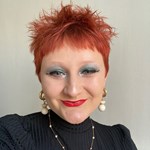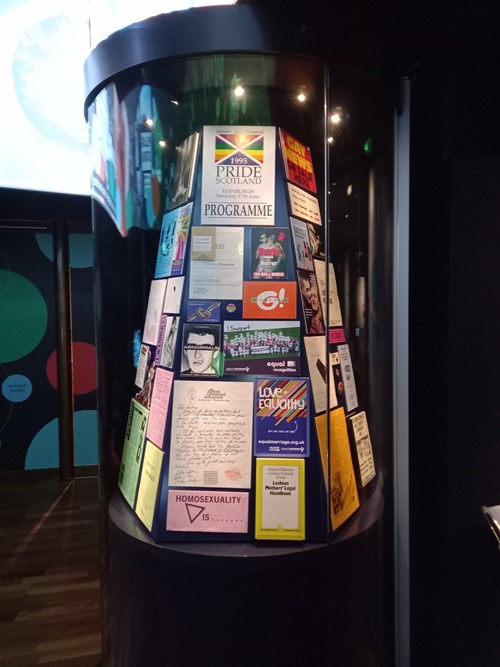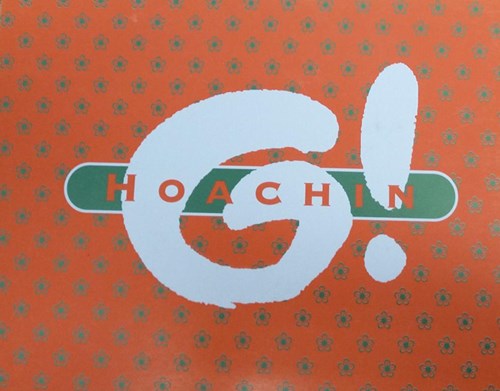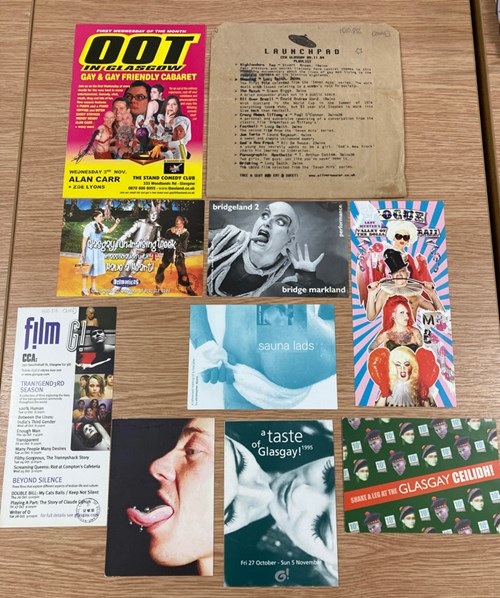
Reading Time: 5 minutes
Long readWritten by Carmen Hesketh

LGBTQ+ display
Queer people in Scotland have always existed. Our current LGBTQ+ Staff Network display highlights pivotal histories of gay activism and struggles for liberation. But it also importantly showcases queer joy and positivity within the Library's collections. Representing multiple perspectives of LGBTQ+ history means visitors get a more rounded picture of what it has meant to be a queer person living in Scotland. Showing what it's like to be happy, here and queer is a powerful statement.
Choosing the material to include in the display was fascinating. Along with the rest of the LGBTQ+ group, I looked through collection and archival material pulled together by one of our curators. The idea was to select one or two items each. We were looking for diverse and intersectional perspectives. Poignant, funny, important and bold items. One of the objects that caught my eye was a promotional postcard for Glasgay!, an LGBTQ+ arts festival.

The Treasures display case.
What was 'Glasgay'?
Glasgay! was founded by performer and writer Cordelia Ditton and freelance arts administrator Dominic D'Angelo. They wanted to increase visibility of Glasgow's gay community and its contribution to art and culture. The festival ran from 1993 until 2014.
As someone from the West of Scotland, I loved being able to see two key aspects of my identity – Glaswegian and queer – come together in a way I hadn't seen before.

The promotional postcard for Glasgay!. "Hoachin" is a popular Glaswegian word meaning "very busy".
My own identity
For a lot of my life, it has been difficult for me to come to terms with being queer. I grew up in a Catholic area of North Lanarkshire and at school I was taught a very traditional, 'heteronormative' view of relationships (the idea that a heterosexual or 'straight' relationship is the 'norm' or the default).
I remember being in a Religious Education class in high school, where I finally plucked up the courage to sheepishly ask my teacher why they only talked about straight relationships. They said that while people may have 'thoughts' of homosexuality, acting on them was something 'sinful and bad'. This encounter, along with being bullied by my peers for being gay (I wasn't 'out' yet, though it seemed like there were many people around me who knew before I fully did!) meant that I associated the confusing feelings I felt around my sexuality with shame.
I also loved learning about history at school, but I noticed that what we focused on was difficult for me to see myself in and relate to. When I visited heritage organisations like museums and galleries, I found them intimidating and felt that they weren't for 'people like me', a working-class, queer, disabled person.
I studied history at university because I wanted to be a teacher and tell other working-class young people about the history of their communities. But when I was a student, I volunteered at a local archive. I couldn't believe I was allowed to hold a piece of history in my hands (patient record books that were over 200 years old). I felt incredibly privileged to catch a small glimpse of the lives of ordinary people living in Scotland. I started pursuing a career in cultural heritage so that I could help to make sure that less privileged types of history were recorded and represented too.
When I came across the Glasgay! postcard, I had no idea that such a festival had even existed in Scotland, never mind that it had taken place for years on my doorstep. When the festival stopped in 2014, I was still a very confused, lonely teenager and a festival like Glasgay! could've provided me with a crucial lifeline into a visible queer community that just didn't exist at home.
Glasgay! in our collections
The Library has over 30 million items in its collections, from traditional books (we certainly have plenty of those!) to other things such as ephemeral material. These are items often designed to be used for a short period of time, such as posters, pamphlets and leaflets. Marginalised communities have often made informational materials amongst themselves on a very low budget, and as a result most of our LGBTQ+ collections at the Library are ephemeral.
Many of our LGBTQ+ collections, including our materials on Glasgay!, are available to view for free in our General Collections Reading Room in our George IV Bridge building in Edinburgh. You just need to be a member of the Library (also free).
Our collections on Glasgay! are also mostly ephemeral in nature. They are colourful, lively, and full of rich information about the history of the festival. For example, we have copies of festival guides for almost every year Glasgay! was running, and every single one highlights the diversity of the events on offer. There were themed queer club nights in iconic Glaswegian nightlife venues such as Bennetts, Café Delmonicas and The Arches. Ticketed events featuring LGBTQ+ legends such as Scottish poet Jackie Kay, English actor Sir Ian McKellan and American film-maker John Waters. Also exhibitions, theatrical performances and talks on LGBT+ issues and history. It's no surprise that Glasgay! was described as "Scotland's annual celebration of LGBT culture".
Our Glasgay! collections also demonstrate the perseverance of the festival's organisers, who created the festival and kept it running during an extremely difficult time for many LGBTQ+ people. When the first festival started in 1993, queer communities were still being disproportionately affected by the HIV and AIDS epidemics and Section 28. The latter was a law which banned the 'promotion of homosexuality' in British local authorities.

Glasgay! postcards
Our records show that Glasgay! and its funders were also initially heavily criticised by the tabloid press for daring to exist. One mainstream newspaper headline read "Taxpayer Funds Gays' Jamboree", expressing disdain that a festival for the gay community would receive public funds. Despite this, Glasgay! prospered to become the largest lesbian and gay arts festival in Europe, raising awareness for queer rights and issues while also being upbeat and fun.
In addition to 'Hoachin', other Glasgay! promotional postcards from the series include popular Glaswegian words like 'bahookie' (backside), 'laldy' (energy/vigor) and 'winch' (kiss). From this series alone it's clear that the festival managed to keep its Scottish identity, and specifically Glaswegian flair, while fostering a global audience.
Glasgay! retires
Glasgay! consistently faced struggles with funding over its lifetime. The festival was funded by Scottish Arts Council (now Creative Scotland) and Glasgow City Council for several years. In 2015, the festival was unsuccessful in receiving funding, and as a result it was unfortunately retired.
I think this is one of the many reasons why it's crucial that heritage organisations like the Library preserve and document collections like this. Otherwise, this fascinating element of Scottish LGBTQ+ history would be at a real risk of being lost to future generations.

Selection of postcards.
Gala Scotland, the company who ran the festival after founders Cordelia and Dominic stepped down in 1995, rebranded to become Outspoken Arts Scotland. This is a Paisley-based arts charity dedicated to empowering marginalised artists.
It's brilliant to see that the ethos of Glasgay! (a dedicated space for LGBTQ+ people in Scotland to express themselves through art and creativity) has continued beyond the festival.
I still live in hope that one day, a festival for queer communities by queer communities will take place in the streets of Glasgow once more!
About the author
Carmen Hesketh (she/her) is one of our Special Collections Assistant, where she assists Library readers visiting the Special Collections Reading Room to access our Archives and Manuscripts and Rare Books and Music collections.
Passionate about researching areas of Scottish "history from below" (areas of marginalised history that often slip through the cracks) Carmen's own area of research is about how Scottish cultural organisations like museums and archives sensitively record the nation's history of HIV and AIDS.







